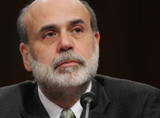 The Federal Reserve said on Wednesday that it was likely to raise interest rates at the end of 2014, but not until then, adding another 18 months to the expected duration of its most basic and longest-running
The Federal Reserve said on Wednesday that it was likely to raise interest rates at the end of 2014, but not until then, adding another 18 months to the expected duration of its most basic and longest-running
The announcement means that the Fed does not expect the economy to complete its recovery from the 2008 crisis over the next three years. By holding short-term rates near zero beyond mid-2013, its previous estimate, the Fed hopes to hasten that process somewhat by reducing the cost of borrowing.
The Fed said in a statement that the economy had expanded “moderately” in recent weeks, but that unemployment remained at a high level, the housing sector remained in a deep depression, and events in Europe continued to threaten renewed prosperity.
The statement, released after a two-day meeting of the Fed’s policy-making committee, said that the Fed intended to keep rates near zero until late 2014.
In a separate set of statements, the Fed said that it now expected the economy to expand between 2.2 and 2.7 percent this year, a slightly slower pace than its November forecast that growth could reach 2.9 percent.
But it added that it still expected the pace of growth to accelerate in the following years. As a result, the Fed said that 11 of the 17 members of the committee expected that the Fed would raise interest rates by the end of 2014.
The combination of the two statements suggested that any such increase would happen at the very end of the year. It is the first time that the Fed has published such a forecast of its own monetary policy decisions.
The decision was supported by nine members of the committee. Jeffrey Lacker, president of the Federal Reserve Bank of Richmond, dissented.
The new forecast is part of an effort by the Fed to exert greater influence over the expectations of investors to increase the impact of its policies. The Fed can influence current interest rates directly, but its influence over future rates depends on what investors think the Fed will do in the future. Ben S. Bernanke, chairman of the Fed, has long advocated clarity and transparency as basic tools of monetary policy.
The economic impact is likely to be relatively modest. Investors already expected the Fed to keep rates near zero into 2014, a judgment reflected in the prices of various assets whose values depend on the movement of interest rates.
Moreover, interest rates on many kinds of borrowing already are hovering near historical lows, and pushing rates down gets harder as you approach zero. Finally, the normal benefits of low interest rates have been lessened by tight lending standards that make it impossible for many people and businesses to qualify for loans.
The Fed also reduced its forecast of growth in 2013, to up to 3.2 percent instead of 3.5 percent. The projections show that most members of the committee expect the economy to gain steam over the next few years – growth in 2014 could reach a pace of 4 percent, according to the forecast – but that growth will not be quick. The economy still will not be operating at full capacity, so prices and wages will remain relatively unchanged.
The current pace of growth is not fast enough to significantly reduce the number of people who need work. Almost 24 million Americans could not find full-time jobs in December. A major reason that the official unemployment rate has declined in recent months is that many people have stopped looking for work.
The Fed projects that unemployment will drop no lower than 8.2 percent this year, just slightly below the 8.5 percent rate in December, and no lower than 7.4 percent next year.
By the end of 2014, the Fed still expects that at least 6.7 percent of people actively interested in working will not be able to find jobs.
And the housing market remains in a deep depression. Construction of new homes fell to the lowest level on record in 2011, and sales of existing homes were equally scarce despite the availability of mortgage loans at the lowest interest rates in history. Millions of homeowners continue to face foreclosure.
Both the World Bank and the International Monetary Fund recently estimated that the United States would achieve growth of about 2 percent in 2012, in line with the estimates of many private forecasters.
Under Mr. Bernanke, the Fed already has started to publish more frequent forecasts of other economic data, including the pace of growth, inflation and unemployment. Mr. Bernanke began to hold regular news conferences last year; he is scheduled to answer media questions four times this year, after every other meeting of the policy-making committee. And the Fed increasingly has offered guidance about its own future decisions, in particular gradually extending the period over which it intends to hold rates near zero.
Since the beginning of the financial crisis in 2007, the Fed has alternated bursts of activity with periods of rest to judge whether it has, at last, done enough to revive the economy. The Fed announced this summer that the central bank intends to keep interest rates near zero through at least the middle of 2013, and that it would seek to reduce long-term interest rates through changes in the kinds of investments that it holds in its nearly $3 trillion portfolio. Since then, two meetings have passed without the introduction of any new programs.
Some Fed officials have suggested that the Fed should buy mortgage-backed securities, as it did in 2009, to further reduce interest rates on mortgage loans, which already are near record lows. Such a program also could reduce interest rates on other kinds of loans, such as corporate borrowing. Officials say that the possibility of new asset purchases remains under consideration.
The forecast shows that 11 of the 17 governors and regional Fed presidents expect the Fed to end its policy of holding short-term interest rates near zero by the end of 2014.
The numbers increase steadily with each passing year. Three committee members expect the Fed to raise rates this year and six expect the central bank to do so next year. The median view of the 17 members of the committee is that rates will remain near zero at the end of 2012 and the end of 2013, and will rise to 0.5 percent by the end of 2014.
In combination with the Fed’s statement Wednesday, their views suggest that the first increase in interest rates would come at the very end of 2014. The forecast is an imperfect window, however, because only 10 members actually hold votes at any given time.
Moreover, the Fed’s chairman exercises outsize authority. The general view of the Fed’s intentions would be sharply altered if it were revealed, for example, that Mr. Bernanke was among the six members expecting rates to remain near zero at the end of 2014.
{NY Times/Matzav.com Newscenter}











